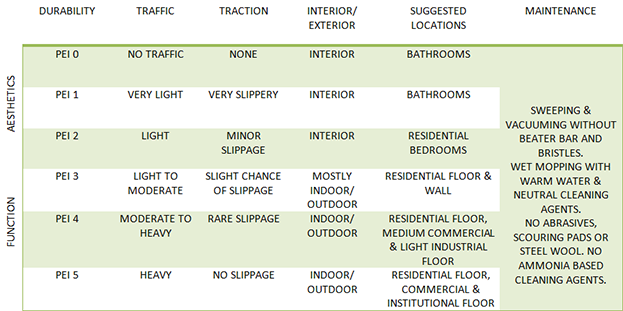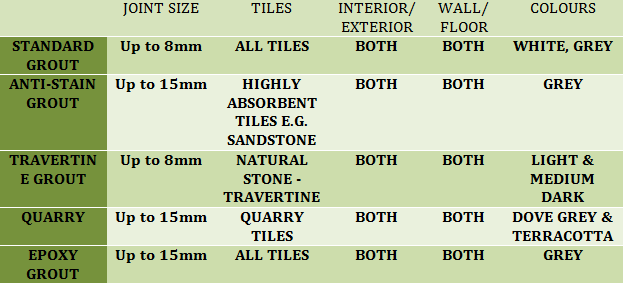CERAMIC & PORCELAIN
Slippery when Wet:
First, decide on whether the tiles will be laid on the interior or exterior of the project. Tiles can be slippery and cause injury if someone falls on the hard surface.
The finish of the tile determines how much traction a tile will have. A high gloss ceramic tile will be very slippery, especially when wet while a matte finish tile will provide greater traction. In other words, a high gloss ceramic tile is usually used for interior wall applications.
That being said some tiles are manufactured with non-skid finishes providing the possibility for glazed ceramic tile to be used outside (e.g. patio)
Foot traffic:
Secondly, determine how much foot traffic your tiles will be exposed to. The Porcelain Enamel Institute rating (PEI) classifies both ceramic and porcelain tiles in terms of their abrasion, resistance, and overall durability. The scale ranges from 0 – 5 (0 for the lightest foot traffic and 5 for the heaviest foot traffic).
Generally, the lower the PEI rating the more important the aesthetic design (i.e. high gloss, metallic finishes or special colours) and the higher the PEI rating the more important the tiles function before its design.

Sizing
Just because a room is small does not mean that a small tile should be used. By using a larger tile in a smaller room, one can visually increase the size of the room.
NATURAL STONE
It is important to note that no two stone tiles are the same making it impossible to match each tile with others. What gives natural stone flooring such a unique look is the overall design and feel of these different tiles coming together.
Sealing is recommended for all natural stone products to make it less porous, more stain resistant and protects the stone’s original beauty.
Depending on the product and where it is laid, resealing is required every 3 – 5 years.

ADHESIVES
Due to the vast number of adhesives available in the market today combined with the various products we offer your sales representative will advise you which adhesive will be best for the job.
The following factors should be taken into account:
(i) The thickness of the tile;
(ii) Wall or floor application;
(iii) Whether the tile is ceramic, porcelain, natural stone, mosaic, listello, manufactured stone an so on;
(iv) Foot traffic;
(v) Residential, commercial or industrial application area;
(vi) Cure times; and
(vii) Interior or exterior application.
GROUT

For all quarry and non-glazed porous tiles, it is recommended that the tiles be sealed before grouting to prevent staining.
Grout lines also play a large role in the sizing of the tiles used. Fewer grout lines (i.e. larger tiles) create a cleaner surface appearance with the focus on the tiles as a whole flooring application. When more grout lines are used (i.e. smaller tiles), the surface may look cluttered with the focus being placed one the individual tiles instead of a larger picture.
LAMINATE AND VINYL
Laminate and vinyl flooring are alternative flooring applications to traditional tiles, hardwood, or natural stone. They both offer a cheaper alternative and are easier to maintain.
Laminate flooring can be used to replicate any type of hardwood or natural stone flooring without the price tag. Due to their process of manufacture they are easy to keep clean, designed to prevent staining or fading and do not require sealing. They also do not require any grout.
Vinyl flooring is the chosen alternative for kitchens, bathrooms, and laundries. Designed to be impervious to fading, scratches, stains and dents, vinyl flooring is easy to keep clean. It is also water resistant and can imitate hardwood, natural stone, and ceramic tiles.
The colour palette for both laminate and vinyl flooring is large with most colour variations available.